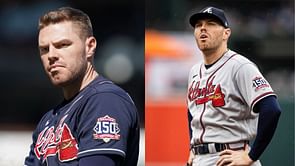
The MLB Playoffs or what it is most commonly known by is Major League Baseball Postseason. It is an annual competition that is held after the end of the regular season. The goal of this competition is to decide the World Series champion among the Major League teams from each league i.e. the American League and the National League. The top teams from the regular season qualify for the playoffs.
The postseason usually involves several rounds of series, including the Wild Card series, Division Series, League Championship Series (LCS), and then the World Series. Teams compete in a series of best-of-five or best-of-seven games, with the winners advancing to the next round until two teams face off in the World Series to compete for the championship title.
Major League Baseball- Playoffs History
Early Playoff System (1903–1968)
The MLB playoffs began with a simple structure, featuring just the World Series between the American League (AL) and National League (NL) champions. From 1903 to 1968, the team with the best record in each league advanced directly to the World Series, making it a best-of-seven championship.
Introduction of League Championship Series (1969–1993)
In 1969, MLB expanded to 24 teams, dividing each league into East and West divisions. The League Championship Series (LCS) was introduced as a best-of-five series, pitting the top teams from each division against each other. In 1985, the format was changed to a best-of-seven series, which is still used today.
Addition of the Wild Card (1994–2011)
The 1994 season brought a major shift with the creation of three divisions (East, Central, and West) in each league, along with the addition of a Wild Card team. The new format featured a Division Series round, where division winners and the Wild Card team competed in a best-of-five series to reach the LCS.
Expanded Playoffs and New Wild Card Format (2012–2019)
In 2012, a second Wild Card team was added to each league, leading to a single-elimination Wild Card Game between the two Wild Card teams. This format increased the intensity and excitement of the postseason, as teams had to win a single game to reach the Division Series.
12-Team Playoff Structure (2022–Present)
The playoff structure was expanded in 2022 to include 12 teams: six from each league. This format includes three division winners and three Wild Card teams per league, with the top two division winners earning a bye to the Division Series. The Wild Card Series is now a best-of-three, followed by the Division Series, LCS, and World Series.
Major League Baseball Playoffs Format
The MLB postseason features twelve teams, six from each league, consisting of three division winners and three wild card teams. The playoffs start with the Wild Card Series, where the wild card teams compete to advance. These games are held at the home parks of the higher-seeded teams over three days.
Following the Wild Card Series, the Division Series takes place, featuring the winners of the Wild Card Series and the three division champions. This round is structured as a best-of-five series with a 2-2-1 format, allowing teams to benefit from home-field advantage.
The winners of the Division Series progress to the League Championship Series (LCS), which is a best-of-seven matchup. Finally, the champions of the American League and National League face off in the World Series, also conducted as a best-of-seven series to determine the ultimate champion.
Wild Card Series
The Wild Card Series format was introduced in 2022, allowing twelve teams from both leagues to compete. Teams qualify as division champions, with three from each league, and are seeded based on winning percentages. The top two division winners receive byes, while the best non-division winners fill the wild card slots.
In the Wild Card Series, the three wild card teams engage in a best-of-three playoff to decide who advances to the Division Series. This format intensifies the competition, providing a thrilling start to the postseason.
Division Series
The Division Series consists of a best-of-five format, with matchups between the three division champions and the Wild Card Series winners. Historically, home-field advantage has varied, but since 2022, the top two division winners with the best records enjoy home-field advantage.
The Division Series is structured as 2-2-1, allowing each team to host games. This format ensures that both teams have the opportunity to play at home, creating a more balanced competitive environment.
League Championship Series
The League Championship Series (LCS) began in 1969 and has evolved significantly. Initially, it was a best-of-five series, but it shifted to a best-of-seven format in 1985. The LCS features the winners of the Division Series competing for the league title.
As of 2023, all thirty MLB teams have participated in the LCS. This stage of the postseason is critical, as it determines which team will represent their league in the World Series.
World Series
The World Series is the pinnacle of MLB, showcasing the champions of the American League and National League in a best-of-seven series. This series has a rich history dating back to 1903, with teams vying for the ultimate title in baseball.
The format for the World Series has been 2-3-2 since 1924, designed to help with travel costs. Since 2017, the league champion with the better regular-season record has been awarded home-field advantage, making each game critical in the pursuit of the championship.
The World Series has been contested 119 times (as of 2023), with the AL teams winning 68 times and the NL teams winning 51 times.
Major League Baseball - Playoffs 2023 Results
Here’s a table of the 2023 World Series Results:
| WORLD SERIES |
| Friday: October 27, 2023 Game 1: Texas Rangers 6, Arizona Diamondbacks 5 (11) (Texas led, 1-0) |
| Saturday: October 28, 2023 Game 2: Arizona Diamondbacks 9, Texas Rangers 1 (Series tied, 1-1) |
| Monday: October 30, 2023 Game 3: Texas Rangers 3, Arizona Diamondbacks 1 (Texas led, 2-1) |
| Tuesday: October 31, 2023 Game 4: Texas Rangers 11, Arizona Diamondbacks 7 (Texas led, 3-1) |
| Wednesday: November 1, 2023 Game 5: Texas Rangers 5, Arizona Diamondbacks 0 (Texas won, 4-1) |
Here’s a table of the 2023 Wild Card Series Results:
| WILD CARD SERIES |
| Tuesday: October 3, 2023 Game 1: Texas Rangers 4, Tampa Bay Rays 0 (Texas led, 1-0) Game 1: Minnesota Twins 3, Toronto Blue Jays 1 (Minnesota led, 1-0) Game 1: Philadelphia Phillies 4, Miami Marlins 1 ( Philadelphia led, 1-0) Game 1: Milwaukee Brewers 3, Arizona Diamondbacks 6 (Arizona led, 1-0) |
| Wednesday: October 4, 2023 Game 2: Texas Rangers 7, Tampa Bay Rays 1 (Texas won, 2-0) Game 2: Minnesota Twins 2, Toronto Blue Jays 0 (Minnesota won, 2-0) Game 2: Philadelphia Phillies 7, Miami Marlins 1, ( Philadelphia won, 2-0) Game 2: Milwaukee Brewers 2, Arizona Diamondbacks 5 (Arizona won, 2-0) |
Here’s a table of the 2023 League Championship Series Results:
| DIVISION SERIES |
| Saturday: October 7, 2023 Game 1: Texas Rangers 3, Baltimore Orioles 2 (Texas led, 1-0) Game 1: Houston Astros 6, Minnesota Twins 4 (Houston led, 1-0) Game 1: Philadelphia Phillies 3, Atlanta Braves 0 (Philadelphia led, 1-0) Game 1: Arizona Diamondbacks 11, Los Angeles Dodgers 2 (Arizona led, 1-0) |
| Sunday: October 8, 2023 Game 2: Texas Rangers 11, Baltimore Orioles 8 (Texas led 2-0) Game 2: Minnesota Twins 6, Houston Astros 2 (Series tied 1-1) |
| Monday: October 9, 2023 Game 2: Atlanta Braves 5, Philadelphia Phillies 4 (Series tied 1-1) Game 2: Arizona Diamondbacks 4, Los Angeles Dodgers 2 (Arizona led, 2-0) |
| Tuesday: October 10, 2023 Game 3: Houston Astros 9, Minnesota Twins 1 (Houston led, 2-1) Game 3: Texas Rangers 7, Baltimore Orioles 1 (Texas won, 3-0) |
| Wednesday: October 11, 2023 Game 3: Philadelphia Phillies 10, Atlanta Braves 2 (Philadelphia led, 2-1) Game 4: Houston Astros 3, Minnesota Twins 2 (Houston won, 3-1) Game 3: Arizona Diamondbacks 4, Los Angeles Dodgers 2 (Arizona won, 3-0) |
| Thursday: October 12, 2023 Game 4: Philadelphia Phillies 3, Atlanta Braves 1 (Philadelphia won, 3-1) |
Here’s a table of League Championship Series Results:
| LEAGUE CHAMPIONSHIP SERIES |
| Sunday: October 15, 2023 Game 1: Texas Rangers 2, Houston Astros 0 (Texas led, 1-0) |
| Monday: October 16, 2023 Game 2: Texas Rangers 5, Houston Astros 4 (Texas led, 2-0) Game 1: Philadelphia Phillies 5, Arizona Diamondbacks 3 (Philadelphia led, 1-0) |
| Tuesday: October 17, 2023 Game 2: Philadelphia Phillies 10, Arizona Diamondbacks 0 (Philadelphia led, 2-0) |
| Wednesday: October 18, 2023 Game 3: Houston Astros 8, Texas Rangers 5 (Texas led, 2-1) |
| Thursday: October 19, 2023 Game 3: Arizona Diamondbacks 2, Philadelphia Phillies 1 (Philadelphia led, 2-1) Game 4: Houston Astros 10, Texas Rangers 3 (Series tied, 2-2) |
| Friday: October 20, 2023 Game 5: Houston Astros 5, Texas Rangers 4 (Houston led, 3-2) Game 4: Arizona Diamondbacks 6, Philadelphia Phillies 5 (Series tied, 2-2) |
| Saturday: October 21, 2023 Game 5: Philadelphia Phillies 6, Arizona Diamondbacks 1 (Philadelphia led, 3-2) |
| Sunday: October 22, 2023 Game 6: Texas Rangers 9, Houston Astros 2 (Series tied, 3-3) |
| Monday: October 23, 2023 Game 6: Arizona Diamondbacks 5, Philadelphia Phillies 1 (Series tied, 3-3) Game 7: Texas Rangers 11, Houston Astros 4 (Texas won, 4-3) |
| Tuesday: October 24, 2023 Game 7: Arizona Diamondbacks 4, Philadelphia Phillies 2 (Arizona won, 4-3) |
FAQ's on MLB Playoffs
A. The MLB Playoffs are about 32 to 53 games long.
A. Six teams from each of the two leagues comprising the MLB, namely the American League and the National League, qualify for the playoffs.
A. Yes, the MLB players are paid for playoffs. They are given playoff bonuses by the leagues based on their percentage of revenue generated during the playoffs.
A. The MLB playoffs typically consist of series played in a best-of-five or best-of-seven format, depending on the round.
A. Yes, MLB teams do make monetary returns from playoffs









